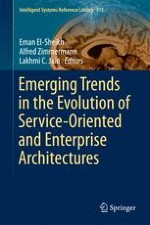This book presents emerging trends in the evolution of service-oriented and enterprise architectures. New architectures and methods of both business and IT are integrating services to support mobility systems, Internet of Things, Ubiquitous Computing, collaborative and adaptive business processes, Big Data, and Cloud ecosystems. They inspire current and future digital strategies and create new opportunities for the digital transformation of next digital products and services. Services Oriented Architectures (SOA) and Enterprise Architectures (EA) have emerged as a useful framework for developing interoperable, large-scale systems, typically implementing various standards, like Web Services, REST, and Microservices. Managing the adaptation and evolution of such systems presents a great challenge. Service-Oriented Architecture enables flexibility through loose coupling, both between the services themselves and between the IT organizations that manage them. Enterprises evolve continuously by transforming and extending their services, processes and information systems. Enterprise Architectures provide a holistic blueprint to help define the structure and operation of an organization with the goal of determining how an organization can most effectively achieve its objectives. The book proposes several approaches to address the challenges of the service-oriented evolution of digital enterprise and software architectures.
